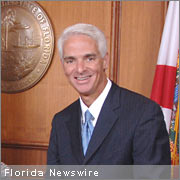FRANCIS S. TAYLOR WILDLIFE MANAGEMENT AREA /Florida Newswire/ -– Governor Charlie Crist today toured the Florida Everglades with United States Senator Bill Nelson and United States Secretary of the Interior Ken Salazar to discuss Florida’s natural resources. Governor Crist highlighted Florida’s commitment to the Comprehensive Everglades Restoration Plan (CERP), the 50/50 state and federal partnership to restore and protect the Everglades. He also discussed the long-term needs of the Apalachicola-Chattahoochee-Flint (ACF) river basin.
 “The Florida Everglades is a place known throughout the world for its abundant wildlife, and it is also essential to the water supply of the people of Florida,” Governor Crist said. “I have made Everglades restoration and the conservation of Florida’s natural resources a high priority so that future generations can experience the Florida we love.”
“The Florida Everglades is a place known throughout the world for its abundant wildlife, and it is also essential to the water supply of the people of Florida,” Governor Crist said. “I have made Everglades restoration and the conservation of Florida’s natural resources a high priority so that future generations can experience the Florida we love.”
Also joining Governor Crist for the tour were Florida Department of Environmental Protection Secretary Michael W. Sole and Thomas Strickland, United States Interior Assistant Secretary for Fish and Wildlife and Parks.
“I am grateful to Senator Nelson, Secretary Salazar and Assistant Secretary Strickland for taking the time to explore America’s Everglades, and to meet with the stakeholders whose support is crucial to the restoration of this one-of-a-kind ecosystem,” said Secretary Sole. “It is especially important right now, to renew our commitment and cooperation to the federal/state partnership, and reaffirm our dedication to completing the projects needed to restore the River of Grass.”
During the tour, Governor Crist encouraged Secretary Salazar to enlist federal support for Everglades restoration and a resolution to the tri-state water controversy. Specifically, Governor Crist requested the following items:
Partnership to Preserve the River of Grass
Governor Crist acknowledged President Obama’s request for $279 million for Everglades restoration funding in the federal Fiscal Year 2010 budget and requested that the partnership continue. He also asked that the Department of the Interior review the expectations and long-term goals of Everglades restoration.
Preserving Florida’s Waterways
Governor Crist also called on Secretary Salazar to address the tri-state water controversy over the management of the reservoirs on the Apalachicola, Chattahoochee and Flint river systems. He emphasized that the impacts of drought on the three-river basin are not limited to Georgia. The drought and resulting flow reductions also threaten the very existence for some 1,300 families of third and fourth-generation oystermen and the economy of the Apalachicola community. Florida’s Apalachicola River and Bay is the most productive contained commercial fishery in Florida.
“This is a tri-state problem which requires a tri-state solution, and it is imperative that we work toward a long-term solution, or else we will find ourselves facing a crisis every year,” Governor Crist said. “Florida recognizes that a solution must include an equitable sharing of adversity.”
Governor Crist encouraged the Department of the Interior to engage in meaningful and independent participation as Florida, Georgia and Alabama explore equitable sharing of water resources. He also requested that the Department of the Interior conduct a comprehensive review of the cumulative downstream effects that have occurred to threatened and endangered species, as well as the environment. The review would quantify the impacts associated with the federal government’s management of the system.
About the Apalachicola-Chattahoochee-Flint River Basin
In December 2007, Governor Crist met with Georgia Governor Sonny Perdue and Alabama Governor Bob Riley at the Governor’s Mansion in Tallahassee to discuss water conservation and a revised schedule of water flow. Since then, the Governors have continued to discuss the steps needed to move toward a new drought protocol for all three states, along with participation from the United States Department of the Interior, the U.S. Army Corps of Engineers and the U.S. Fish & Wildlife Service.
The total commercial fishing industry in the Apalachicola Bay is responsible for $134 million in direct economic output and an additional $71 million in indirect value-added impacts. The region produces 90 percent of Florida’s oyster supply, 10 percent of the nation’s oysters, and the state’s third-largest shrimp harvest.
About Everglades Restoration
Florida’s Everglades restoration efforts are truly historic. To date, Florida has invested more than $2.4 billion in the 30-year, $10.9 billion Comprehensive Everglades Restoration Plan, the 50/50 state and federal partnership to restore and protect the Everglades. During the two tightest budget years in Florida history, $50 million has been dedicated for Everglades restoration in both 2008 and 2009 to continue the state’s partnership with the federal government. The Governing Board of the South Florida Water Management District recently agreed to invest approximately $530 million for 72,500 acres of property south of Lake Okeechobee. The district will have an option to purchase another 107,500 acres for restoration within 10 years after closing.
In 2007, Governor Crist worked to expand the Lake Okeechobee Protection Act to safeguard the entire northern Everglades system, including the Lake Okeechobee watershed as well as the Caloosahatchee and St. Lucie rivers and estuaries. He has worked to protect and improve the quality, quantity, timing and distribution of water north of Lake Okeechobee. Additionally, the continuation of the Florida Forever program is a key component to securing the future of the Everglades.


